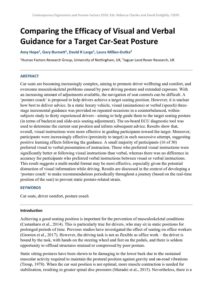| Document | Author Amy Hope, Gary Burnett, David R Large, Laura Millen-Dutka |
| Abstract Car seats are becoming increasingly complex, aiming to promote driver wellbeing and comfort, and overcome musculoskeletal problems caused by poor driving posture and extended exposure. With an increasing amount of adjustments available, the navigation of seat controls can be difficult. A ‘posture coach’ is proposed to help drivers achieve a target seating position. However, it is unclear how best to deliver advice. In a static luxury vehicle, visual (animations) or verbal (speech) three-stage incremental guidance was provided on repeated occasions in a counterbalanced, within-subjects study to thirty experienced drivers - aiming to help guide them to the target seating posture (in terms of backrest and slide-axis seating adjustment). The on-board ECU diagnostic tool was used to determine the current seat position and inform subsequent advice. Results show that, overall, visual instructions were more effective in guiding participants toward the target. Moreover, participants were increasingly effective (proximity to target) in each successive attempt, suggesting positive learning effects following the guidance. A small majority of participants (16 of 30) preferred visual to verbal presentation of instruction. Those who preferred visual instructions were significantly better at following visual instructions than verbal, whereas there was no difference in accuracy for participants who preferred verbal instructions between visual or verbal instructions. This result suggests a multi-modal format may be most effective, especially given the potential distraction of visual information while driving. Results are discussed in the context of developing a ‘posture coach’ to make recommendations periodically throughout a journey (based on the real-time position of the seat) to prevent static posture-related strain. |

